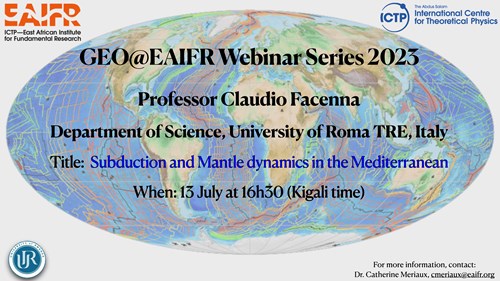ICTP-East African Institute for Fundamental Research
KIST2 Building CST
Nyarugenge Campus
University of Rwanda
Kigali, Rwanda
GEO@EAIFR Webinar Series 2023
Professor Claudio Faccenna from the Department of Science of the University of Roma TRE will discuss the subduction and mantle dynamics in the Mediterranean.

The East African Institute for Fundamental Research (EAIFR) and the International Centre for Theoretical Physics (ICTP) wish to inform those who may be interested of a GEO@EAIFR webinar. This seminar will take place on July 13, 2023 and will be broadcast live on ZOOM. It will also be recorded and later posted on the ICTP-EAIFR YouTube channel, where one can find the previous recorded GEO@EAIFR webinars. Below all the details:
Speaker: Professor Claudio Faccenna, Department of Science of the University of Roma TRE and head of section at GFZ Potsdam. E-mail: Faccenna@uniroma3.it
Title: Subduction and Mantle dynamics in the Mediterranean
When: July 13, 2023 at 16:30 (Kigali time).
Register in advance for this meeting by clicking here.
All are very welcome.

Biography: Claudio Faccenna is Full Professor at the Dept. of Science of the University of Roma TRE and head of section at GFZ Potsdam. Trained as a structural geologist, he focused his research on tectonics and geodynamics, studying subduction, mountain building, and more in general, the connection between mantle convection, and surface deformation. He has been mostly working in the Mediterranean and Middle East. in the northern Andes and more recently in the Caribbean. He is presently working on mechanism of mountain building and dynamic topography, merging geological and geophysical data with modelling.
Author of more than 250 scientific papers, he is serving as EiC of G-Cubed. He is member of the Academia Europaea, and he received the prix Viquesnel from the Societé Geologique de France (2013), Stephan Muller medal from EGU (2014) and the von Humboldt Research award (2015) and Fellow of the American Geophysical Union (2017).
Abstract: The Mediterranean offers a unique opportunity to study the driving forces of tectonic deformation within a complex mobile belt. Lithospheric dynamics are affected by slab rollback and collision of two large, slowly moving plates, forcing fragments of continental and oceanic lithosphere to interact. In this talk we will review the rich and growing set of constraints from geological reconstructions, geodetic data, and crustal and upper mantle heterogeneity imaged by structural seismology. We proceed to discuss a conceptual and quantitative framework for the causes of surface deformation. Exploring existing and newly developed tectonic and numerical geodynamic models, we illustrate the role of mantle convection on surface geology. A coherent picture emerges which can be outlined by two, almost symmetric, upper mantle convection cells. The downwellings are found in the center of the Mediterranean and are associated with the descent of the Tyrrhenian and the Hellenic slabs. During plate convergence, these slabs migrated backward with respect to the Eurasian upper plate, inducing a return flow of the asthenosphere from the back-arc regions toward the subduction zones. This flow can be found at large distance from the subduction zones and is at present expressed in two upwellings beneath Anatolia and eastern Iberia. This convection system provides an explanation for the general pattern of seismic anisotropy in the Mediterranean, first-order Anatolia, and Adria microplate kinematics and may contribute to the high elevation of scarcely deformed areas such as Anatolia and eastern Iberia. More generally, the Mediterranean is an illustration of how upper mantle, small-scale convection leads to intraplate deformation and complex plate boundary reconfiguration at the westernmost terminus of the Tethyan collision.



